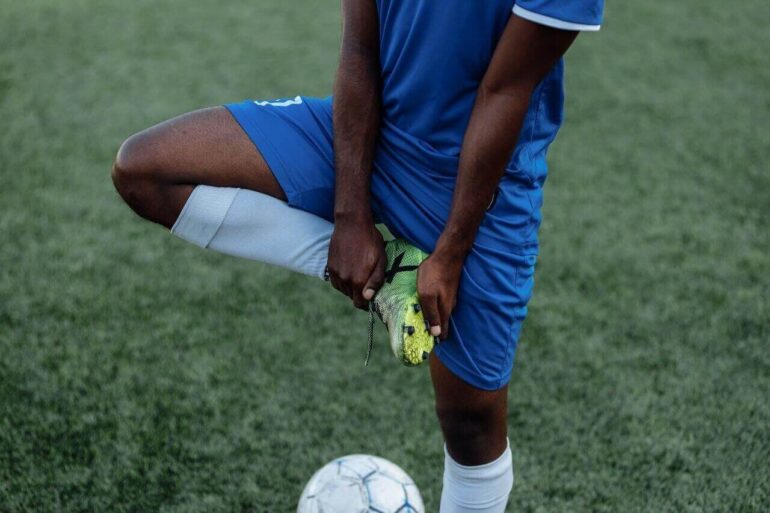The Achilles tendon is a fibrous connective tissue that attaches the lower calf muscle to the heel bone. Every time we walk or run, this tendon is stretched to make us move forward. However, in some cases, the tendon can overstretch and thus tear apart. This condition is termed an Achilles injury or Achilles tendon rupture.
The condition usually arises due to overstretching the respective tendon which is a common occurrence while playing sports.
In some patients, the Achilles tendon is asymptomatic while in others, symptoms like severe pain in the foot, inability to bend the foot, as well as the presence of a snapping sound can be observed.
Whatever the situation may be, the following tools are helpful in diagnosing and treating Achilles injury.

Diagnostic Tools to Confirm Achilles Tendon Injury
For making an accurate diagnosis of Achilles injury, one should visit a physician who may adopt the following practices:
Physical Examination:
During physical examination, the physician may ask the patient to lie down flat on his or her stomach and then evaluate the respective foot. The presence of inflammation, tenderness, and a gap between the heel and calf muscle give away Achilles injury.
Ultrasound:
Portable ultrasound machines can also be employed to take a scan of the affected area. Being a non-invasive as well as painless process, the method is patient-compliant and gives clear visualization of the extent of damage.
MRI Scan:
An MRI scanner can also be employed if the physician deems it suitable. These machines are capable of creating images of the ruptured tissue thus providing help in understanding the severity of the injury.
Initial Treatment: Equipment for Immediate Care
Although the treatment protocol often depends on the patient’s age, the severity of the injury, and activity level, the following interventions are helpful in all cases:
(a) Non-Surgical Interventions
Non-surgical interventions include the use of the following:
Cold Packs & Compression Wraps:
The application of ice on the affected area is the first approach that needs to be adopted. Icing and wrapping the area immediately helps reduce the pain and swelling.
Immobilization Boots:
For the first few weeks after the injury, the use of immobilization boots lets the patients move without moving their ankles. Boots with heel wedges or a cast are the preferred choice in this regard.
Crutches:
Apart from the immobilization boots, crutches can also be recommended to patients with Achilles injury as these aid mobility without putting too much pressure on the feet.
(b) Surgical Intervention
Surgery can also be performed to repair the ruptured Achilles tendon. For this purpose, the back of the lower leg is incised and the torn tendon is stitched up. Both minimally invasive procedures as well as open surgeries can be performed to achieve recovery. However, the chances of nerve damage and infection are lesser for the former.

Rehabilitation: Tools for Effective Recovery
Once the injury has been healed, the patient is advised to start physical therapy which involves certain muscle-strengthening exercises. Although the estimated functional rehabilitation period for Achilles injury is between 4 to 6 months, these exercises should be continued for a year to minimize the risk of side effects of the treatment which may develop in later stages. In this regard, the following are also employed:
Resistance Bands:
Resistance bands are used to perform calf muscle exercises which help in their toning as well as strengthening. The resistance band is wrapped around the ball of the foot and its ends are held by hand. The band is pulled so that the foot is flexed. By continuously doing so, the foot and leg muscles start gaining strength.
Ankle Braces:
Ankle braces are used by patients with Achilles tendons as these are good at applying pressure to the affected area. These braces help reduce pain and provide support to the ruptured tendon. As the ankle braces restrict the movement of the tendon, the injury does not aggravate due to moving.
Orthotic Insoles:
Orthotic insoles work by minimizing the strain put on the affected tendon as a result of moving. This way, the injured area is kept free from excessive load thus facilitating recovery. Moreover, the chances of the foot getting twisted are also reduced.

Preventing Re-Injury: Supplies for Ongoing Support
To prevent an Achilles re-injury, a person should incorporate certain muscle-strengthening exercises into their daily routine. These muscle stretches taken along with the precautionary measures not only heal the previous injury but also enable the muscle to combat pressure while walking thus preventing re-injury. Some of these measures include the following:
Kinesiology Tape (KT):
To enhance the blood flow to the Achilles tendon, kinesiology tape is employed which is a cotton and nylon-based elastic band used to mimic the skin’s elasticity. This not only results in an enhanced speed of recovery but also offloads the affected joint consequently reducing pain and swelling.
Foam Rollers:
Foam rollers are used to exercise the affected leg. By rolling the muscle onto the roller, myofascial tension is released, pain is reduced, and the recovery process is stimulated.
Choosing the Right Equipment: Trusting Quality Suppliers
Choosing the right equipment supplier ensures the provision of top-quality medical goods in minimum time. In addition, the price of each item should also be justifiable. Therefore, while making a purchase, take into consideration the following key points:
– The price of the item should be justifiable.
– Products must be of good quality.
– The location of the supplier must be approachable.
– Your business values must align with those of the supplier.
All of the medical scissors mentioned in this article, along with other medical supplies, can be purchased from Health Supply 770 at the most affordable prices. Furthermore, the prices are even lower during the weekly deals they offer on certain items. Do check them out for stocking up on some essential supplies.
Conclusion
Achilles injury is a health issue related to the rupture of the Achilles tendon present between the foot heel and the lower leg. This results in severe pain and immobility. Treatment protocol includes both surgical as well as non-surgical interventions.
However, once the patient has completed the treatment, going back to normal mobility routine is fully achievable.
As the Achilles injury is not only restricted to the athletes, anyone can get affected by it which makes it important for everyone to be prepared for emergencies and have a stock of essential medical supplies.
For this purpose, care should be taken while choosing a supplier as reliable medical suppliers such as Health Supply 770 are hard to find.

PhD Scholar (Pharmaceutics), MPhil (Pharmaceutics), Pharm D, B. Sc.
Uzma Zafar is a dedicated and highly motivated pharmaceutical professional currently pursuing her PhD in Pharmaceutics at the Punjab University College of Pharmacy, University of the Punjab. With a comprehensive academic and research background, Uzma has consistently excelled in her studies, securing first division throughout her educational journey.
Uzma’s passion for the pharmaceutical field is evident from her active engagement during her Doctor of Pharmacy (Pharm.D) program, where she not only mastered industrial techniques and clinical case studies but also delved into marketing strategies and management skills.

















